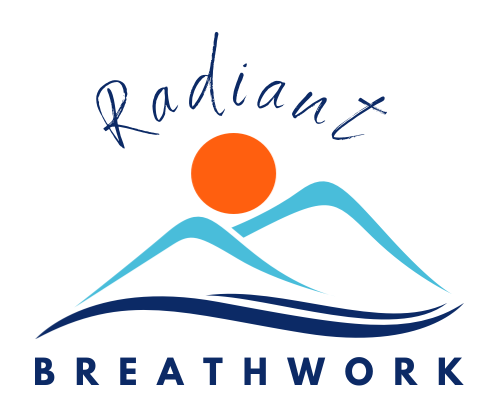Radiant Breathwork blog
Inhale, Exhale, Feel Alive!
The Physical Benefits of Breathwork
Jon - Radiant Breathwork, 18 April 2024
"For breath is life, so if you breathe well you will
live long on earth."
-
Sanskrit Proverb
In this post, part of a new series on the benefits of breathwork, I explore the physical benefits of Transformational Breath®. Specifically, the use of diaphragmatic or belly breathing.

The Diaphragm and its Importance for Healthy Breathing
The diaphragm, a large muscle located beneath the lungs, plays a crucial role in expanding and contracting your lungs.
Diaphragmatic breathing, or “belly breathing,” uses the diaphragm, intercostal, abdominal, and pelvic floor muscles. This means actively pulling the diaphragm down with each inward breath, helping your lungs fill more efficiently.
However, due to stress and misuse, the diaphragm often does not work fully. Many people unnecessarily use muscles in their back, chest, or belly when breathing, which makes for a lot of hard work!
A core benefit of Transformational Breath® is to help you 'relearn' how to use your diaphragm so you can breathe more fully and freely, opening you to the full potential of your respiratory system
Below is a simplified animation of diaphragmatic breathing, showing how the diaphragm (shown in green) moves under the lungs to help you breathe deeply in and out.

The 5 key benefits of Diaphragmatic breathing
On the physical level, full, connected diaphragmatic breathing has been shown to have a wide range of benefits:
- Increases oxygenation throughout your body.
- Helps reduce stress and anxiety by stimulating and regulating the vagus nerve and the parasympathetic nervous system.
- Improves wellbeing for many respiratory conditions such as asthma.
- Boosts immunity and increases energy levels.
- It can also help to enhance the quality of your sleep.
Let’s look at each in turn in a bit more detail.
1. Increases oxygenation throughout your body:
Full, connected diaphragmatic breathing ensures that your lungs fully expand and contract, allowing more oxygen to enter your bloodstream. This increased oxygenation supports the functioning of vital organs, muscles, and tissues. It also aids cellular regeneration and repair, promoting overall health and vitality.

2. Helps reduce stress and anxiety:
Diaphragmatic Breathing can activate your parasympathetic nervous system (PNS) by engaging the diaphragm and regulating the breath. This promotes relaxation and reduces your body's stress response.
Stimulating the vagus nerve through deep breathing techniques further enhances this calming effect, decreasing stress hormone levels such as cortisol. Regular breathwork practice can give you a sense of calmness and resilience, empowering you to manage stress and anxiety more effectively.
Try this out for yourself
When you find yourself in a stressful situation and become aware you're shallow breathing in your chest, put your hands on your hips, focus on breathing into your belly, and see how that shifts your state. Another thing to try is at the start of the day, especially Monday mornings! Just before you open your email, check you are not holding your breath, and focus on breathing into your belly. Holding your breath is a very common thing to do as a form of bracing when you are expecting to see, hear or experience something challenging. If you keep breathing, it will help keep you more centred and grounded.
3. Improves wellbeing for respiratory conditions:
Conscious breathing techniques such as Transformational Breath® can be especially beneficial if you have respiratory conditions such as asthma, bronchitis, and chronic obstructive pulmonary disease (COPD).
Breathwork can help alleviate symptoms and improve respiratory function over time by strengthening your respiratory muscles and increasing lung capacity.
Additionally, breathwork can be effective in managing various psychosomatic illnesses, including tension headaches, digestive disorders, and chronic pain conditions.
4. Boosts immunity and increases energy levels:
Deep, rhythmic breathing supports your lymphatic system, which plays a crucial role in immune function by removing toxins and waste products from the body. Improved circulation and oxygenation from breathwork also enhances your body's ability to combat infections and illness. The increased flow of oxygen and energy throughout your body can promote feelings of vitality and alertness, leading to overall wellbeing.

5. Enhances the quality of sleep:
Practising breathwork before bedtime can help calm your mind and body, making it easier to fall asleep and achieve deeper, restorative sleep. By promoting relaxation and reducing stress levels, breathwork can alleviate common sleep disturbances such as insomnia, night sweats, and restless leg syndrome. Incorporating breathwork into your bedtime routine can lead to more consistent and restful sleep patterns, allowing you to wake up feeling more refreshed each morning.
Why don’t we naturally breathe this way?
As you can see, diaphragmatic breathing has some great physical benefits, so why is it not the standard way we breathe? Well, the answer is life! Most of us breathe this way as babies, but as time goes on, stress and bad habits start to impede the natural breathing pattern we were born with. For example, when stressed, many people breathe in their chests and not in their bellies, exacerbating the stress and making shallow breathing become the default breathing pattern.

The benefits of Body Mapping
To get back to belly breathing, we must ‘unlearn’ the unhelpful breathing habits we have acquired throughout life. This requires some practice, but learning techniques like Transformational Breath® can help.
Body mapping is a specific part of the Transformational Breath® technique that enables you to achieve a full diaphragmatic breath more easily and quickly.
Body mapping is similar to acupressure in some respects. Its main purpose is to help the body release tension in areas that are inhibiting a full diaphragmatic breath. These areas include the belly, chest, shoulders, and back.
In a breathwork session, we facilitators apply pressure, typically using fingers and hands, to these areas through observation and intuition to free up tension and help the breath flow. One of the most common areas we do this is the solar plexus just below the sternum—an area with a lot of tension and holding; after applying pressure, it’s common to see the diaphragm release and start to work more freely.
Conclusion
Breathing in the belly, or diaphragmatic breathing, is a great way to improve your overall health and wellbeing. While it takes time to change life long habits, the benefits are well worth it. Transformational Breath® with it’s body mapping technique is one of the fasted ways to relearn how to breathe fully and freely.
In my next blog post in this series, I’ll explore in more detail the mental and emotional benefits of breathwork.
Experience the power of Breathwork for yourself
If this post has made you curious to find out more about trying breathwork for yourself, why not
Book a free chat
with us?
Blog posts
Deepen Your Bond with Nature’s Secrets through Breathwork
28 February 2024
Online Transformational Breath® sessions explained
25 January 2024
Support for your Breath journey
30 October 2023
The Benefits of Transformational Breath®
10 October 2023
What's a Transformational Breath® session like?
09 October 2023

